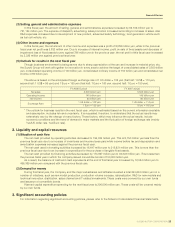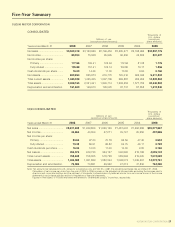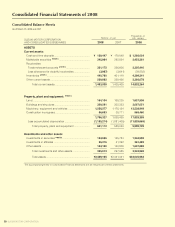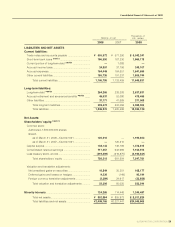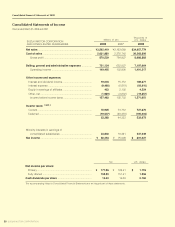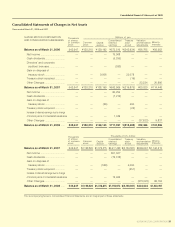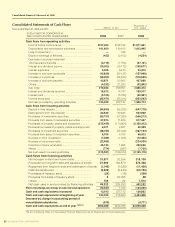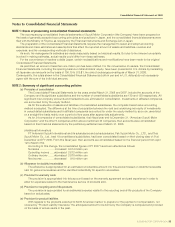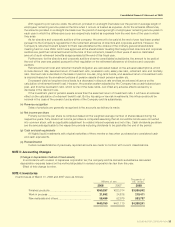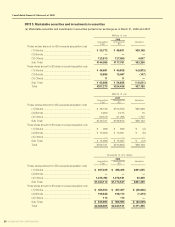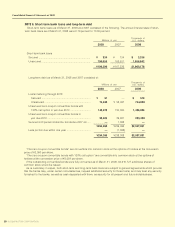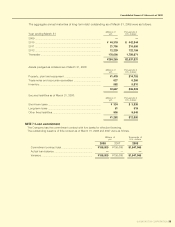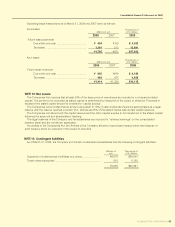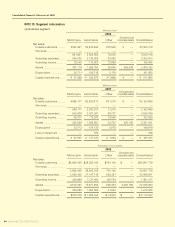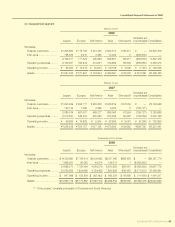Suzuki 2008 Annual Report Download - page 36
Download and view the complete annual report
Please find page 36 of the 2008 Suzuki annual report below. You can navigate through the pages in the report by either clicking on the pages listed below, or by using the keyword search tool below to find specific information within the annual report.
SUZUKI MOTOR CORPORATION 35
With regard to prior service costs, the amount, prorated on a straight line basis over the period of average length of
employees’ remaining service years at the time when it occurs, is treated as expense. As for the actuarial differences,
the amounts prorated on a straight line basis over the period of average length of employees’ remaining service years in
each year in which the differences occur are respectively treated as expenses from the next term of the year in which
they arise.
As for directors and corporate auditors of the company, the amount to be paid at the end of year had been posted
pursuant to the Company’s regulations on the retirement allowance of directors and corporate auditors. However, the
Company’s retirement benefit system for them was abolished at the closure of the ordinary general shareholders’
meeting held on June 2006. And it was approved at the shareholders’ meeting that reappointed directors and corporate
auditors are paid their retirement benefit at the time of their retirement, based on their years of service. Estimated
amount of such retirement benefits is appropriated at the end of this fiscal year.
Furthermore, for the directors and corporate auditors of some consolidated subsidiaries, the amount to be paid at
the end of the year was posted pursuant to their regulation on the retirement allowance of directors and corporate
auditors.
Retirement benefit cost and retirement benefit obligation are calculated based on the actuarial assumptions, which
include discount rate, assumed return of investment ratio, revaluation ratio, salary rise ratio, retirement ratio and mortality
ratio. Discount rate is decided on the basis of yield on low-risk, long-term bonds, and assumed return of investment ratio
is decided based on the investment policies of pension assets of each pension system etc.
Decreased yield on long-term bond leads to a decrease in discount rate and has an adverse influence on the
calculation of retirement benefit cost. However, the pension system adopted by the Company has a cash balance type
plan, and thus the revaluation ratio, which is one of the base ratios, can offset any adverse effects caused by a
decrease in the discount rate.
If the investment yield of pension assets is less than the assumed return of investment ratio, it will have an adverse
effect on the calculation of retirement benefit cost. But by focusing on low-risk investments, this influence should be
minimal in the case of the pension fund systems of the Company and its subsidiaries.
(n) Revenue recognition
Sales of products are generally recognized in the accounts as delivery is made.
(o) Net income per share
Primary net income per share is computed based on the weighted average number of shares issued during the
respective years. Fully diluted net income per share is computed assuming that all convertible bonds were converted
into common stock, with an applicable adjustment for related interest expense and net of tax. Cash dividends per share
are the amounts applicable to the respective periods including dividends to be paid after the end of the period.
(p) Cash and cash equivalents
All highly liquid investments with original maturities of three months or less when purchased are considered cash
and cash equivalents.
(q) Reclassification
Certain reclassifications of previously reported amounts are made to conform with current classifications.
NOTE 3: Accounting Changes
(Change in depreciation method of fixed assets)
In accordance with revision of Japanese corporation tax, the company and its domestic subsidiaries calculated
depreciation expense based on the method stipulated in revised corporation tax law from this year.
Effect of this change is minor.
NOTE 4: Inventories
Inventories as of March 31, 2008 and 2007 were as follows:
Consolidated Financial Statements of 2008
Finished products ........................................................ ¥360,287 ¥323,314 $3,596,042
Work in process ........................................................... 21,982 24,816 219,411
Raw materials and others ............................................. 58,489 52,979 583,787
¥440,760 ¥401,110 $4,399,241
2008 2007 2008
Thousands of
U.S. dollars
Millions of yen


